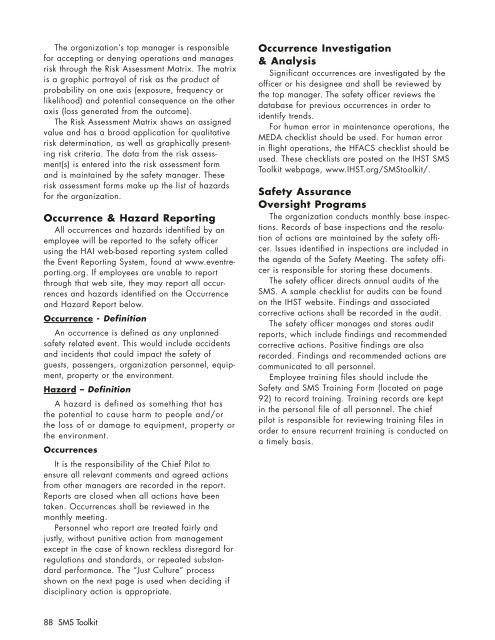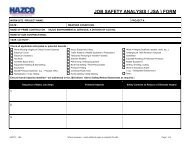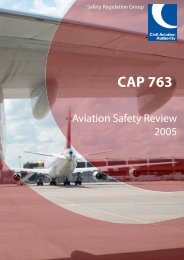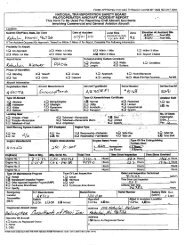International Helicopter Safety Team Safety Management System Toolkit
IHST - Safety Management Toolkit - Skybrary
IHST - Safety Management Toolkit - Skybrary
- No tags were found...
You also want an ePaper? Increase the reach of your titles
YUMPU automatically turns print PDFs into web optimized ePapers that Google loves.
The organization’s top manager is responsible<br />
for accepting or denying operations and manages<br />
risk through the Risk Assessment Matrix. The matrix<br />
is a graphic portrayal of risk as the product of<br />
probability on one axis (exposure, frequency or<br />
likelihood) and potential consequence on the other<br />
axis (loss generated from the outcome).<br />
The Risk Assessment Matrix shows an assigned<br />
value and has a broad application for qualitative<br />
risk determination, as well as graphically presenting<br />
risk criteria. The data from the risk assessment(s)<br />
is entered into the risk assessment form<br />
and is maintained by the safety manager. These<br />
risk assessment forms make up the list of hazards<br />
for the organization.<br />
Occurrence & Hazard Reporting<br />
All occurrences and hazards identified by an<br />
employee will be reported to the safety officer<br />
using the HAI web-based reporting system called<br />
the Event Reporting <strong>System</strong>, found at www.eventreporting.org.<br />
If employees are unable to report<br />
through that web site, they may report all occurrences<br />
and hazards identified on the Occurrence<br />
and Hazard Report below.<br />
Occurrence - Definition<br />
An occurrence is defined as any unplanned<br />
safety related event. This would include accidents<br />
and incidents that could impact the safety of<br />
guests, passengers, organization personnel, equipment,<br />
property or the environment.<br />
Hazard – Definition<br />
A hazard is defined as something that has<br />
the potential to cause harm to people and/or<br />
the loss of or damage to equipment, property or<br />
the environment.<br />
Occurrences<br />
It is the responsibility of the Chief Pilot to<br />
ensure all relevant comments and agreed actions<br />
from other managers are recorded in the report.<br />
Reports are closed when all actions have been<br />
taken. Occurrences shall be reviewed in the<br />
monthly meeting.<br />
Personnel who report are treated fairly and<br />
justly, without punitive action from management<br />
except in the case of known reckless disregard for<br />
regulations and standards, or repeated substandard<br />
performance. The “Just Culture” process<br />
shown on the next page is used when deciding if<br />
disciplinary action is appropriate.<br />
Occurrence Investigation<br />
& Analysis<br />
Significant occurrences are investigated by the<br />
officer or his designee and shall be reviewed by<br />
the top manager. The safety officer reviews the<br />
database for previous occurrences in order to<br />
identify trends.<br />
For human error in maintenance operations, the<br />
MEDA checklist should be used. For human error<br />
in flight operations, the HFACS checklist should be<br />
used. These checklists are posted on the IHST SMS<br />
<strong>Toolkit</strong> webpage, www.IHST.org/SMStoolkit/.<br />
<strong>Safety</strong> Assurance<br />
Oversight Programs<br />
The organization conducts monthly base inspections.<br />
Records of base inspections and the resolution<br />
of actions are maintained by the safety officer.<br />
Issues identified in inspections are included in<br />
the agenda of the <strong>Safety</strong> Meeting. The safety officer<br />
is responsible for storing these documents.<br />
The safety officer directs annual audits of the<br />
SMS. A sample checklist for audits can be found<br />
on the IHST website. Findings and associated<br />
corrective actions shall be recorded in the audit.<br />
The safety officer manages and stores audit<br />
reports, which include findings and recommended<br />
corrective actions. Positive findings are also<br />
recorded. Findings and recommended actions are<br />
communicated to all personnel.<br />
Employee training files should include the<br />
<strong>Safety</strong> and SMS Training Form (located on page<br />
92) to record training. Training records are kept<br />
in the personal file of all personnel. The chief<br />
pilot is responsible for reviewing training files in<br />
order to ensure recurrent training is conducted on<br />
a timely basis.<br />
88 SMS <strong>Toolkit</strong>







